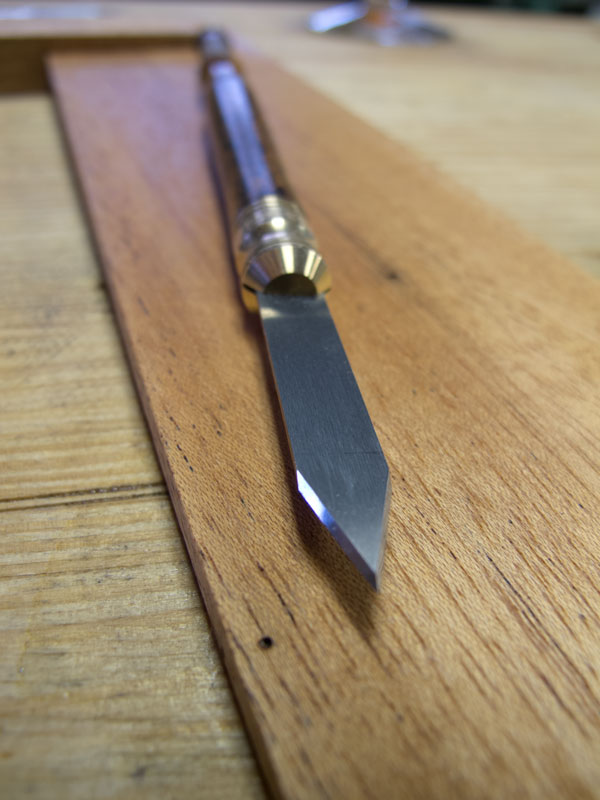We may receive a commission when you use our affiliate links. However, this does not impact our recommendations.
If you don’t like (or cannot) sharpening a marking knife, the new Czeck Edge “Super Kadet II” knife is likely the right choice for your tool chest.
Based on the well-balanced and well-made “Kerf Kadet” knife, this version is like its older brothers with the addition of a tungsten carbide blade. Why a carbide blade? Here’s what the Czeck Edge web site says:
“This carbide blade will make cleaner cuts and do so almost indefinitely without the need to be re-sharpened in normal use.”
Those are big words. So for the last couple months, we’ve been test-driving a Super Kadet II knife in my shop that was loaned to me by Editor Megan Fitzpatrick to see if the knife lived up to its description.
Here are some of the questions I wanted to answer:
1. Can the knife get as sharp as a carbon-steel knife?
2. How long will the edge last?
3. Can it be resharpened?
4. Is it too brittle for shop use?
Here’s what I concluded:
Sharpness: Out of the box, the Super Kadet II feels sharp, though not as sharp as a freshly honed carbon-steel knife. When used side-by-side with a carbon-steel knife, the Kerf Kadet doesn’t seem to penetrate wood fibers as deeply as my personal knife.
When my personal knife is sharp, it jumps into the wood with little pressure and feels wedged in place as I move the knife. The Super Kadet II, on the other hand, offers a different kind of feedback. It doesn’t have that same “sticky” feel. It moves smoothly through the work. It definitely cuts the wood, but the knife line isn’t as pronounced.
What is interesting is that the edge of the Super Kadet II doesn’t degrade like it does on my knife. And this brings me to my second question.
Edge life: I usually sharpen my carbon-steel knife after every project. But even after considerable use on two major projects, the Super Kadet II knife still feels exactly like it did when it was new. I can’t say how long the edge will last, though if it behaves like the other carbide tooling in my shop, I think it’s likely to be years and years.
Sharpening: So I tried to sharpen the Super Kadet II with my typical workshop equipment. My waterstones and oilstones didn’t do a thing to the tool. The carbide wasn’t even scratched by them. However, a diamond plate did an acceptable job of dressing the back and bevels of the knife. I couldn’t get the knife as sharp as my carbon-steel knife, but sharpening it with a diamond plate definitely improved the way the Super Kadet II penetrated the wood, especially end grain.
Brittleness: Carbide can fracture, especially if it is struck. I’ve seen many chipped carbide teeth on table saws, router bits and jointers after they hit something hard, such as a screw, nail or rock that’s embedded in the wood.
I’ve dropped the Super Kadet II knife a few times (once by accident; twice on purpose) with no damage. One of the nice side-benefits of the carbide blade is how stiff it is. It’s much stiffer than my regular knife, which has a blade that is similar in length and thickness. This stiffness is a plus in dovetailing when transferring the tail shape to the pin board. When a thin knife bends it can actually push the tail board left or right.
Other details: Like all of the Czeck Edge products, the Super Kadet II is extremely well made in a one-man shop. The handle is crisply turned, the ferrule is blended perfectly into both the handle and the blade. While you can make your own marking knife, it would be hard to make one that looks this good.
All in all, the Super Kadet II is a primo piece of kit. Like me, you might not need the long (perhaps infinite) edge life of the carbide blade. But if you don’t want to sharpen your knife, or you want one less tool in your chest that needs regular maintenance, then the Super Kadet II is a good call.
— Christopher Schwarz
If you are interested in tools or toolmaking, I highly, highly recommend the new DVD on forging a compass with blacksmith Peter Ross. Even if you don’t plan on becoming a blacksmith, this is an educational look at how tools are made, and Peter is a living treasure.
Here are some supplies and tools we find essential in our everyday work around the shop. We may receive a commission from sales referred by our links; however, we have carefully selected these products for their usefulness and quality.









Afternoon Chris,
I am building your Roubo bench.
It is going well so far. The top is great. 8ft x 24 1/8″.
I am now glueing and drawboring the legs and frame etc.
I have both of your books and I work by myself mostly by hand.
I use a Pillar Drill, mitre saw and power sanders but I try and complete the rest of the jobs by hand.
The question is :-
When I have got the base together and used it to mark out the mortises, after drilling and preparing for drawboring, can I do this with the bench top still being upside down on my trestles? Does it make any difference if I do this rightside up or upside down? It would save me a lot of heavy lifting. Advice please, urgently??
I have enjoyed your books and your blogs, articles etc., when do you get the time for carpentry?
Thanks
David H, Colchester, Essex, UK
What were the results of your tests with the Gladstone ceramic knife (that also never needs resharpening)? (http://tinyurl.com/c8zt3e3)
It was the price that made it too good to pass up. Great product from the deep south.